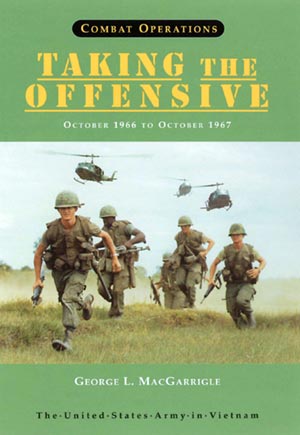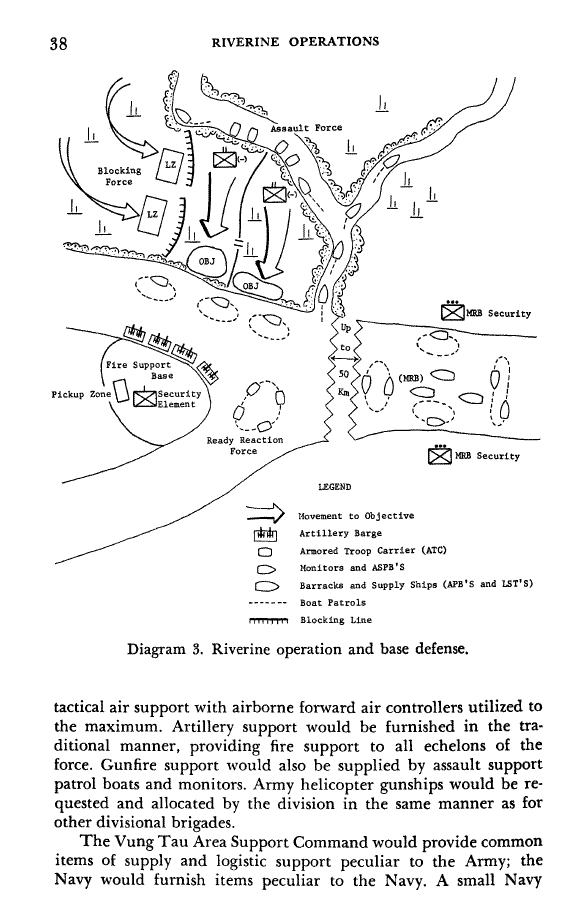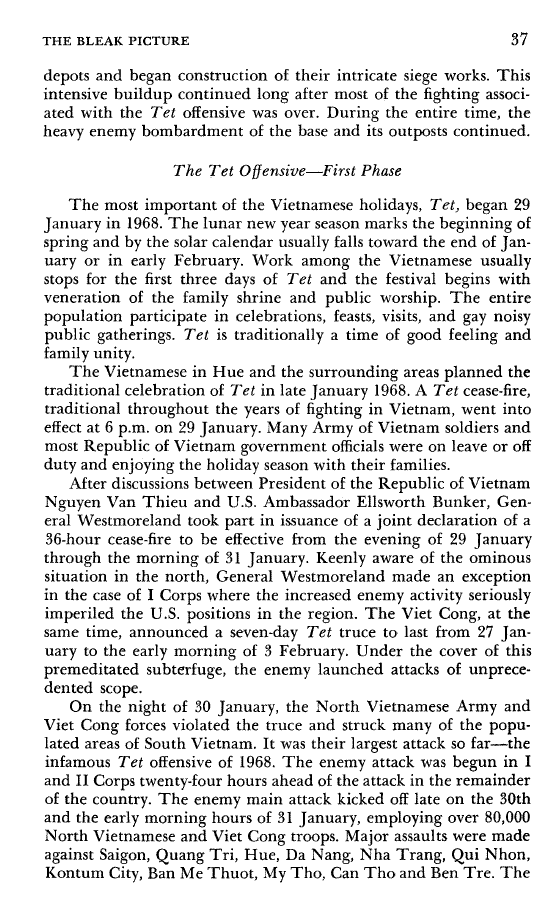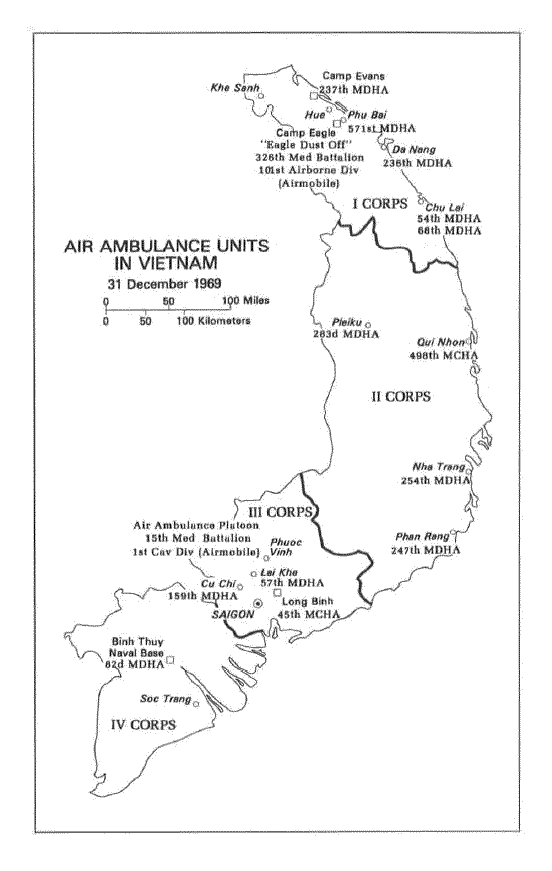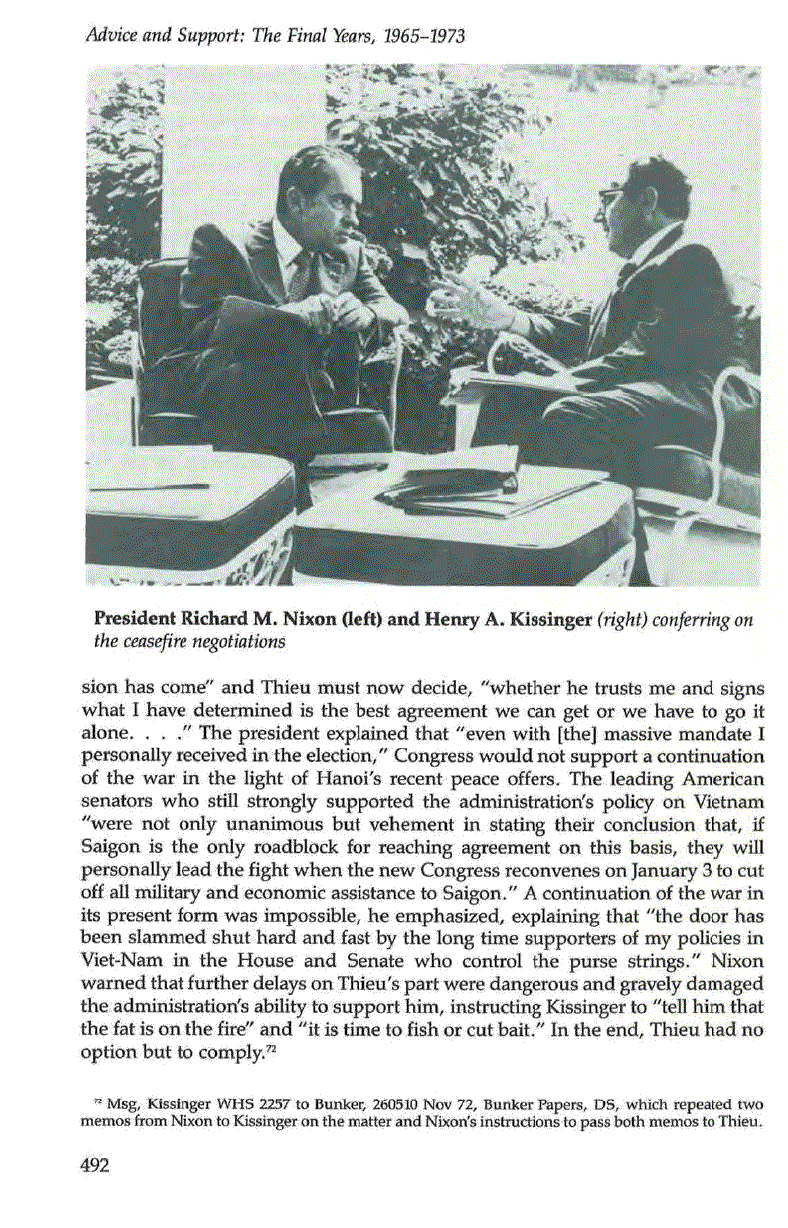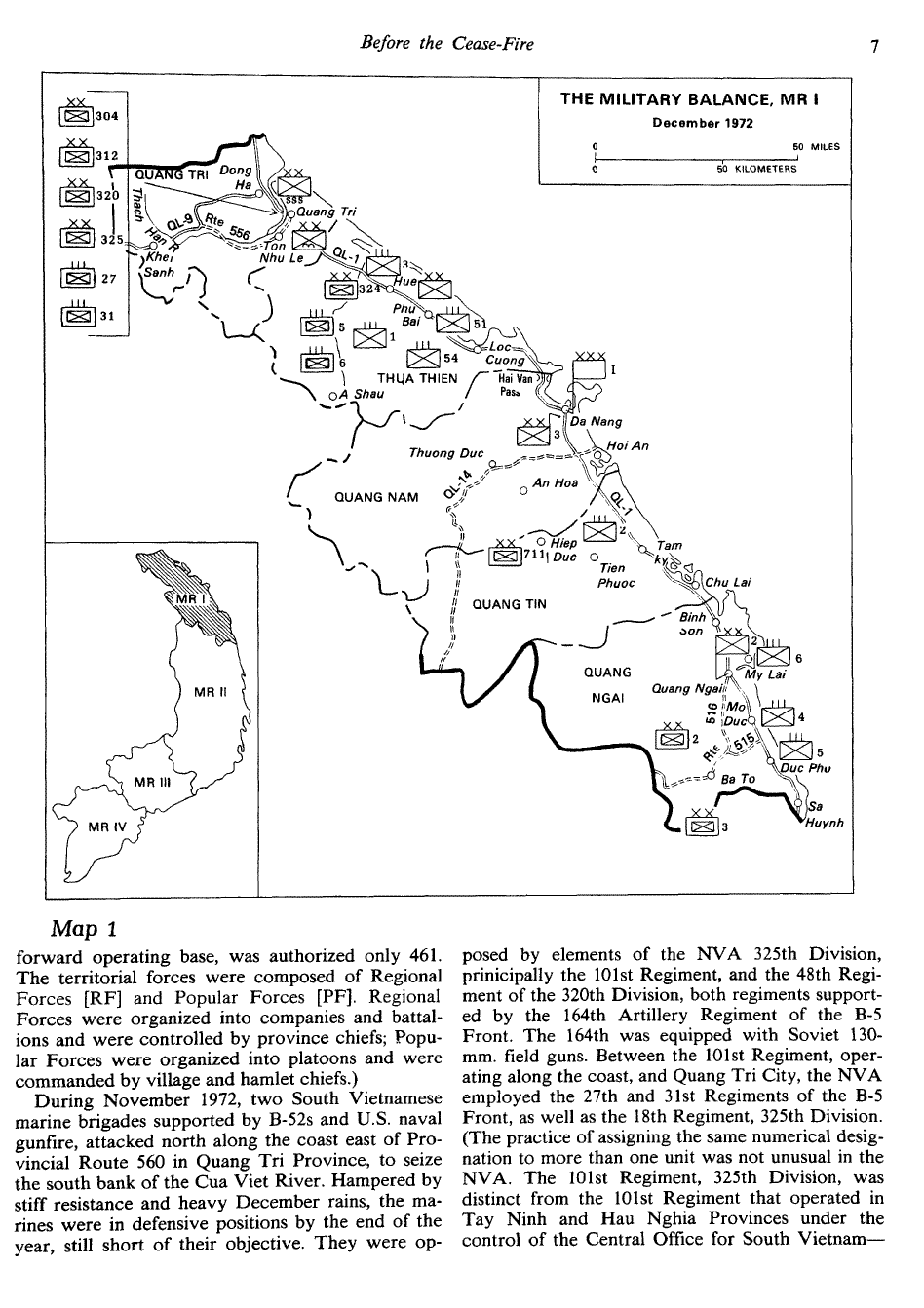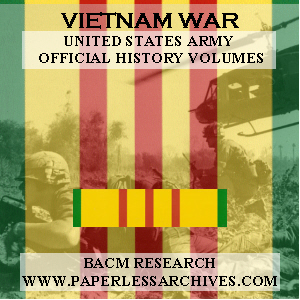|
The earlier volumes consist of shorter monographs produced shorter after or during the end of the Vietnam War. Later volumes consist of longer studies that were the result of The United States Army's historical branch's effort to produce a comprehensive and authoritative history of The United States Army participation in the Vietnam War. These histories are based on official records, additional material from published and unpublished secondary works, from debriefing reports and interviews with key participants, and from the personal experience of the authors.
Volumes include:
Advice and Support: The Early Years, 1941-1960
By Ronald Spector - 1983, 1985; 391 pages, illustrations, maps, tables, charts, bibliographical note, index
Advice and Support describes the activities of the U.S. Army in Vietnam during World War II, military advice and assistance to the French government during the immediate postwar years, and the advisory program that developed after the Geneva Agreements of 1954. Its scope ranges from high-level policy decisions to low-echelon advisory operations in the field, presented against a background of relevant military and political developments. Useful not only as a study of military assistance but as a view of the Army as an agent of national policy, Ronald Spector's interesting book is a fitting introduction to the overall study of the conflict in Vietnam.
Public Affairs: The Military and the Media, 1962-1968
By William M. Hammond - 1988, 1990; 413 pages, illustrations, maps, bibliographical note, index
The Military and the Media examines the evolution of the U.S. government's public affairs policies in Vietnam between 1962 and 1968. Adopting a broad viewpoint in order to depict the many influences - civilian and military, political and diplomatic - that bore upon the conduct of public affairs, the William Hammond's insightful work describes the tensions that developed between the institutions of the press and the military as the war grew and as each served its separate ends. The book observes events from the perspective of the Military Assistance Command's Office of Information in Saigon, which carried much of the burden of press relations, but necessarily considers as well the role of the White House, the State and Defense Departments, and the U.S. embassy in Saigon in the creation of information policy. By drawing together many disparate strands, the book seeks to delineate some of the issues and problems that can confront an open society whenever it wages war.
Public Affairs: The Military and the Media, 1968-1973
By William M. Hammond - 1996; 659 pages, illustrations, maps, tables, bibliographical note, index
Public Affairs: The Military and the Media, 1968-1973, the sequel volume to William M. Hammond's Public Affairs: The Military and the Media, 1962-1968, continue the history and analysis of the relationship between the press and the military during the final years of the Vietnam conflict. Relying on official records and histories, news media sources and interviews, and significant secondary works, Hammond has carefully and capably traced the many turns that public affairs policies and campaigns took to protect military secrets without diminishing the independence of news correspondents. Massive amounts of information were forthcoming without endangering U.S. forces, but neither the press nor the government was totally satisfied with the system. Doubts and criticisms loomed large, giving rise to tensions and disagreements. With some exceptions, the military and the news media became enemies. What happened in Vietnam between the military and the news media was symptomatic of what had occurred in the United States as a whole. Hammond's well-written account raises the issues and problems that can confront an open society at war, documenting events and precedents that will continue to affect military-media relations during future operations. It offers important lessons for soldiers, newsmen, policymakers, and the public at large.
Advice and Support: The Final Years, 1965-1973
By Jeffrey J. Clarke - 1988, 1992; 561 pages, illustrations, maps, tables, charts, appendixes, bibliographical note, index
In Advice and Support: The Final Years, 1965-1973, Jeffrey J. Clarke describes the U.S. Army advisory effort to the South Vietnamese armed forces during the period when the U.S. commitment in Southeast Asia was at its peak. The account encompasses a broad spectrum of activities at several levels, from the physically demanding work of the battalion advisers on the ground to the more sophisticated undertakings of our senior military officers at the highest echelons of the American military assistance command in Saigon. Among critical subjects treated are our command relationships with the South Vietnamese army, our politico-military efforts to help reform both the South Vietnamese military and government, and our implementation of the Vietnamization policy inaugurated in 1969. The result tell us much about the U.S. Army's role as an agent of national policy in a critical but often neglected arena, and constitutes a major contribution to our understanding of not only events that occurred in Vietnam, but also the decisions and actions that produced them.
Combat Operations: Taking the Offensive, October 1966 to October 1967
By George L. MacGarrigle - 1998; illustrations, maps, table, bibliographical note, index
Combat Operations: Taking the Offensive chronicles the onset of offensive operations by the U.S. Army after eighteen months of building up a force on the ground in South Vietnam and taking the first steps toward offensive operations. The compelling story by George L. MacGarrigle begins in October 1966, when General William C. Westmoreland believed that he had the arms and men to take the initiative from the opposition and that significant progress would be made on all fronts over the next twelve months. Aware of American intentions, North Vietnam undertook a prolonged war of attrition and stepped up the infiltration of its own troops into the South. While the insurgency in the South remained the cornerstone of Communist strategy, it was increasingly overshadowed by main-force military operations. These circumstances, according to MacGarrigle, set the stage for intensified combat. The North Vietnamese and Viet Cong units retained the advantage, fighting only when it suited their purposes and retreating with impunity into inviolate sanctuaries in Laos and Cambodia. With Westmoreland feeling hamstrung by political constraints on his ability to wage war in the vast hostile areas along the border, 1967 ended with a growing uncertainty in the struggle to secure the countryside. Relying on official American and opposition primary sources, MacGarrigle has crafted a well-balanced account of this year of intense combat.
Combat Operations: Stemming the Tide, May 1965 to October 1966
By John M. Carland - 2000; 410 pages, illustrations, maps, tables, bibliographical note, index
Combat Operations: Stemming the Tide describes a critical chapter in the Vietnam conflict, the first eighteen months of combat by the U.S. Army's ground forces. Relying on official American and opposition primary sources, John M. Carland focuses on initial deployments and early combat and takes care to present a well-balanced picture by discussing not only the successes but also the difficulties endemic to the entire effort. This fine work presents the war in all of its detail: the opposition's strategy and tactics, General William C. Westmoreland's search and destroy operations, the helicopters and airmobile warfare, the immense firepower American forces could call upon to counter Communist control of the battlefield, the out-of-country opposition sanctuaries, and the allied efforts to win the allegiance of the South Vietnamese people to the nation's anti-Communist government. Carland's volume demonstrates that U.S. forces succeeded in achieving their initial goals, but unexpected manpower shortages made Westmoreland realize that the transition from stemming the tide to taking the offensive would take longer. Bruising battles with the Viet Cong and North Vietnamese in the Saigon area and in the Central Highlands had halted their drive in 1965 and, with major base development activities afoot, a series of high-tempo spoiling operations in 1966 kept them off balance until more U.S. fighting units arrived in the fall. Carland credits the improvements in communications and intelligence, the helicopter's capacity to extend the battlefield, and the availability of enormous firepower as the potent ingredients in Westmoreland's optimism for victory, yet realizes that the ultimate issue of how effective the U.S. Army would be and what it would accomplish during the next phase was very much a question mark.
MACV: The Joint Command in the Years of Escalation, 1962-1967
By Graham A. Cosmas - 2006; 524 pages, maps, illustrations, charts, bibliographical note, index
MACV describes the evolution of the command during the period of gradual expansion of the American effort in South Vietnam. From its establishment in 1962 as a small, temporary organization to administer an assistance program, the Military Assistance Command, Vietnam, grew by late 1967 into a large, permanent headquarters that directed more than half a million American soldiers, sailors, airmen, and marines in a wide range of combat and pacification operations. Graham A. Cosmas tells the story of MACV's development as an organization and of the command's role in making and implementing American national policy in Southeast Asia. The volume treats both national-level decisions and military operations from the perspective of the theater joint commander. It recounts how the MACV commander and his staff viewed the war at various periods and how and why they arrived at their decisions. The volume analyzes the interservice politics of organizing and managing a joint command; MACV's relationship with Pacific Command, the Joint Chiefs of Staff, and the secretary of defense; and the evolution of the command's dealings with its South Vietnamese and third-country allies. As an experiment in nation-building, the story of the Military Assistance Command contains many parallels to more recent Army engagements and so serves as a potential source of important lessons.
MACV: The Joint Command in the Years of Withdrawal, 1968-1973
By Graham A. Cosmas - 2007; 487 pages, maps, illustrations, charts, bibliographical note, index
MACV: The Joint Command in the Years of Withdrawal, 1968-1973, describes the evolution of the command during the period of U.S. disengagement from Vietnam. By late 1967 the Military Assistance Command, Vietnam (MACV), had grown from a small, temporary advisory and assistance organization into a large, permanent headquarters that directed more than half a million American soldiers, sailors, airmen, and marines in a wide range of combat and pacification operations. By that same time, however, President Lyndon B. Johnson and his principal advisers had concluded that it was necessary to begin reducing the cost in lives and money of a seemingly stalemated war. The Communist Tet offensive of January-February 1968 confirmed the president in his decision and set the United States upon a path of disengagement that President Richard M. Nixon also followed. During the period covered by this volume, MACV gradually withdrew its American troops from South Vietnam and worked to prepare Saigon's forces to defend their country by their own efforts. The MACV headquarters itself drew down toward reversion to an assistance and advisory group.
U.S. Army Special Forces, 1961-1971
1973, 2004; 227 pages, tables, charts, maps, illustrations, appendixes, glossary, index
The training of Vietnamese soldiers, Regional Forces, and Popular Forces by U.S. Special Forces troops.
Riviverine Operations, 1966-1969
By Major General William B. Fulton - 1973, 1985; 210 pages, charts, diagrams, tables, maps, illustrations, glossary, index
This monograph describes U.S. Army Riverine planning and operations in the Republic of Vietnam during the years 1966 through 1969. Since the personal experience of the author was with preparations for riverine operations and the initial operations themselves, emphasis has been placed on these activities through early 1968. In summarizing operations conducted in the balance of the three-year period, particular attention has been called to significant trends or changes in riverine operations in Vietnam, a co-operative enterprise of the U.S. Army and the U.S. Navy.
Military Communications: A Test for Technology
By John D. Bergen - illustrations, maps, diagram, bibliographical note, glossary, index
In Military Communications: A Test for Technology, John D. Bergen develops the thesis that burgeoning technology in communications faced a severe test in Vietnam. He analyzes the advantages and drawbacks of new communications systems and the effects these systems had on decision making and on command. In doing so, he describes the difficulties that communications systems had in keeping pace with the information explosion and shows that command and control do not necessarily improve with enhanced communications. The book illustrates that the communicator's missions of "getting the message through" was not only critical to the success of combat operations, but also as challenging as combat itself. Bergen's clear understanding and description of these issues make this a valuable work for those responsible for the future success of command, control, communications, and intelligence.
Engineers at War
by Adrian G. Traas - 2010; 647 pages, illustrations, bibliographical note, glossary, map symbols and terms, index
This volume covers how the engineers grew from a few advisory detachments to a force of more than 10 percent of the Army troops serving in South Vietnam. The 35th Engineer Group began arriving in large numbers in June 1965 to begin transforming Cam Ranh Bay into a major port, airfield, and depot complex. Within a few years, the Army engineers had expanded to a command, two brigades, six groups, twenty-eight construction and combat battalions, and many smaller units
Engineers at War describes the role of military engineers, especially the U.S. Army Corps of Engineers, in the Vietnam War. It is a story of the engineers' battle against an elusive and determined opposition in one of the harshest underdeveloped regions of the world. Despite these challenges, engineer soldiers successfully carried out their combat and construction missions. The building effort in South Vietnam allowed the United States to deploy and operate a modern 500,000-man force in a far-off region. Although the engineers faced huge construction tasks, they were always ready to support the combat troops. They built ports and depots, carved airfields and airstrips out of jungle and mountain plateaus, repaired roads and bridges, and constructed bases. Because of these efforts, ground combat troops with their supporting engineers were able to fight the opposition from well-established bases. Although most of the construction was temporary, more durable facilities, such as airfields, port and depot complexes, headquarters buildings, communications facilities, and an improved highway system, were intended to serve as economic assets for South Vietnam.
SEVEN FIREFIGHTS IN VIETNAM
1970, 2005; 159 pages, maps, illustrations, glossary, index
The events described in this book are illustrative of much that took place in Vietnam after American troops were first committed in force in 1965: of heroic achievement and sacrifice, of human error, of experimentation and innovation, of a wily and elusive enemy, and of a new dimension in warfare afforded by the helicopter. These accounts of fighting in Vietnam are based upon official U.S. Army records, daily journals, journal files, and after action reports; upon interviews conducted soon after the events by historical officers in Vietnam; and upon interviews and correspondence conducted later by the authors themselves.
The Last Salute: Civil and Military Funerals, 1921-1969
1971, 1991; 429 pages, tables, chart, diagrams, illustrations, bibliographical note, appendixes
Accounts of funerals conducted for civil and military officials, active and retired, and for the unknown servicemen of three wars. It also describes ceremonies honoring foreign dignitaries who died while on duty in the United States
The Modern Volunteer Army Program - The Benning Experiment, 1970-1972
1988, 2010; 146 pages, charts, illustrations, appendixes, index
A study of the U.S. Army Infantry Center's participation in Project VOLAR, the field experiment undertaken at selected Army posts to develop, test, evaluate, and refine new concepts and initiatives in support of the Modern Volunteer Army (MVA). Program goals included reduced reliance upon the draft, increased professionalism, enhancement of Army life, and the development of a modern personnel accession system.
Building a Volunteer Army: The Fort Ord Contribution
1975, 1987; 139 pages, tables, charts, illustrations, appendixes, index
Complementing the Benning Experiment volume, this study describes the work of the Fort Ord Training Center in developing and promoting the concept of a modern volunteer Army through the practical application of policies developed in Washington.
Airmobility, 1961-1971
1974, 1989; 304 pages, charts, maps, illustrations, appendix, glossary, index
Air assault operations in Southeast Asia would not have been possible without certain key decisions a decade earlier. This publication traces the most important milestones which led to the eventual formation of airmobile divisions.
Allied Participation in Vietnam
Written by Lieutenant General Stanley Robert Larsen, Brigadier General James Lawton Collins, Jr.
1975, 2005; 189 pages, tables, charts, maps, illustrations, appendix, glossary, index
An account of allied assistance to the Republic of Vietnam and of efforts to enlist that assistance.
Base development in South Vietnam, 1965-1970.
by Lieutenant General Carroll H. Dunn
1972, 1991; 164 pages, tables, charts, maps, illustrations, glossary,
The tasks, accomplishments, and problems of Army engineers in the construction of ports, airfields, storage areas, ammunition dumps, housing, bridges, roads, and other conventional facilities in Vietnam from 1965 to 1970.
Cedar Falls-Junction City: A Turning Point
by Major General Bernard W. Rogers
1974, 2004; 172 pages, chart, maps, illustrations, glossary, index
An analysis of two operations conducted in early 1967 that marked a turning point in both the tide of the battle and the evolution of tactical doctrine.
Command and Control, 1950-1969
by Major General George S. Eckhardt
A study of the development of the U.S. military command and control structure in Vietnam, focusing primarily on the Military Assistance Command, Vietnam, and the U.S. Army, Vietnam
History of Operations Research in the United States Army, Volume 2: 1961-1973
2008; 374 pages, illustrations, charts, figures, appendixes, glossary, bibliography, index
This volume is on the history of operations research identifies, describes, and evaluates the ideas, people, organizations, and events that influenced the development of ORSA in the Army from the inauguration of President Kennedy in 1961 to the withdrawal of U.S. forces from Vietnam in 1973.
The Development and Training of the South Vietnamese Army, 1950-1972
1975, 2002; 163 pages, maps, illustrations, appendixes, glossary, index
Describes building of the South Vietnamese Army, emphasizing the role of the U.S. Army, especially the MACV advisory system.
Division-Level Communications, 1962-1973
1982, 2000; 109 pages, charts, maps, illustrations, glossary, index
U.S. Army communications-electronics activities in Vietnam, with primary focus on the division signal battalion and below, including battalion-level tactical communications, command relationships, procedures, organization, and innovations.
Field Artillery, 1954-1973
1975, 2007; 253 pages, charts, maps, diagrams, illustrations, index
An account of the more important activities, with attendant problems, shortcomings, and achievements of field artillery in Vietnam.
Law at War: Vietnam, 1964-1973
By or General George S. Prugh - 1975, 1991; 161 pages, maps, illustrations, appendixes, index
Covers legal activities of the U.S. Military Assistance Command, Vietnam. General Prugh is particularly well qualified to author this monograph on judge advocate activities at Headquarters, U.S. Military Assistance Command, Vietnam. In November 1964 he became the Staff judge Advocate at the Military Assistance Command, and served in that capacity on an extended tour until July 1966.
Logistic Support
1974; 273 pages, charts, maps, tables, illustrations, appendix, glossary, index
A study of significant actions and events concerning logistical support, including decisions, techniques, accomplishments, and lessons learned during the years 1965 through 1970.
Medical Support of the U.S. Army in Vietnam, 1965-1970
1973, 1991; 196 pages, chart, maps, illustrations, appendixes, glossary, index
An overview of major medical problems encountered, of decisions made, and the lessons learned in Vietnam.
The War in the Northern Provinces, 1966-1968
1975, 1991; 115 pages, charts, maps, diagrams, illustrations, glossary, index
An account of North Vietnamese attempts to seize control of Quang Tri and Thua Thien Provinces and the response of the allied forces, particularly U.S. Army units.
Dust Off: Army Aeromedical Evacuation in Vietnam
1982, 2008; 134 pages, map, bibliographical note, index
An account of Army helicopter ambulances in Vietnam that evaluates leadership, procedures, and logistical support.
Vietnam from Cease-Fire to Capitulation
1981, 2001; 180 pages, maps, tables
An examination of significant military developments and social and economic conditions during the last three years of the war.
PROJECT CHECO SOUTHEAST ASIA REPORT. ARMY AVIATION IN THE REPUBLIC OF VIETNAM: A CASE STUDY
1970
Project CHECO, an acronym for Contemporary Historical Examination of Current Operations. This study profiles the 12th Aviation Group in III CTZ, which supported II Field Force Vietnam, explaining how its aircraft were allocated and used by ground units.
Sharpening the combat edge: the use of analysis to reinforce military judgment.
1975, 1995; 252 pages, charts, maps, tables, illustrations, appendix, glossary, index
The systematic blending of military judgment, data collection, and problem-solving techniques as used in the 9th Infantry Division and II Field Force, Vietnam, 1968-1970.
On Strategy: The Vietnam War in Context.
1982
This study is the culmination of a US Army War College study effort to draw strategic lessons from our Vietnam experience. Using Clausewitzian theory and the classical principles of war, the book attempts to place the Vietnam war in domestic context as well as in the context of war itself. Its central thesis is that a lack of appreciation of military theory and military strategy (especially the relationship between military strategy and national policy) lead to a faulty definition of the nature of the war. The result was the exhaustion of the Army against a secondary guerilla force and the ultimate failure of military strategy to support the national policy of containment of communism expansion. Intended neither as a history of our Vietnam involvement nor as a definitive account of the war, the purpose of the book is to provoke and stimulate military strategic thinking so as to better prepare us to meet the challenges that lie ahead.
|
